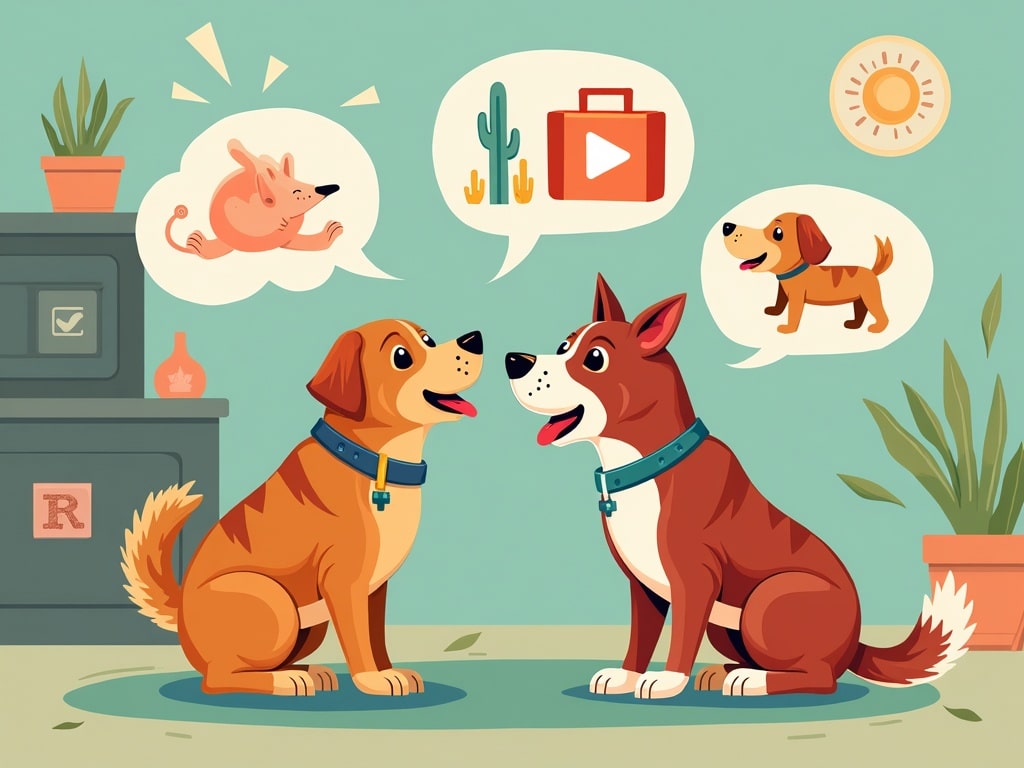No More Noise Complaints: Taming Separation Anxiety Barking for Good
Imagine this: you're at work, trying to focus, when your phone buzzes. It's a text from your neighbor, followed by a photo of a handwritten note taped to your door. Your dog is barking again, it reads. A wave of anxiety washes over you. You love your dog, but their incessant barking when alone is causing serious problems. Noise complaints are piling up, and you're desperate for a solution. This article is your comprehensive guide to understanding and tackling separation anxiety barking, helping you restore peace for both your dog and your neighborhood.
Understanding Separation Anxiety in Dogs
Separation anxiety is more than just a dog missing their owner. It's a distress response triggered by being left alone or separated from their primary caregiver. But what exactly causes it?
What Causes Separation Anxiety?
The exact cause can be multifaceted and vary from dog to dog. Some common triggers include:
- Changes in Routine: A new work schedule, a move to a new home, or even a change in the family dynamic can upset a dog's sense of security.
- Traumatic Events: A frightening experience while alone, such as a thunderstorm or a break-in, can lead to anxiety.
- Loss of a Family Member (Human or Animal): The absence of a bonded companion can trigger separation anxiety.
- Underlying Medical Conditions: In some cases, medical issues can contribute to anxiety. It's always wise to rule out health concerns with your vet.
Beyond the Bark: Recognizing Other Symptoms
Dog barking when alone is the most audible symptom, but separation anxiety manifests in various ways:
- Destructive Behavior: Chewing, scratching, digging, or destroying furniture, door frames, or personal belongings.
- Potty Accidents: Urinating or defecating indoors, even if the dog is house-trained.
- Excessive Drooling or Panting: More than usual, indicating stress.
- Pacing or Restlessness: An inability to settle down or relax.
- Trying to Escape: Desperate attempts to get out of the house or crate.
Separation Anxiety vs. Normal Dog Behavior
It's crucial to distinguish separation anxiety from normal dog behaviors like boredom or attention-seeking. A bored dog might chew on a shoe, but a dog with separation anxiety is more likely to target items with your scent or try to escape. The intensity of the behavior is also a key indicator. Anxious behaviors are often frantic and desperate, whereas normal misbehavior is more casual and opportunistic. Remember, if you need more clarification check out this great resource: https://www.healthypuptraining.com/understanding-separation-anxiety-in-dogs-recognizing-key-symptoms/
Decoding the Bark
Not all barks are created equal. Understanding the nuances of your dog's vocalizations can provide valuable insight into their emotional state.
What Does Separation Anxiety Barking Sound Like?
Separation anxiety barking often has a distinctive quality. It's usually:
- Persistent: It can last for extended periods, sometimes hours on end.
- High-Pitched or Frantic: Often accompanied by whining, howling, or distressed sounds.
- Repetitive: Lacking variation, suggesting a state of distress rather than communication.
Different Kinds of Separation Anxiety Barks
While the general sound is similar, there can be subtle variations:
- Alert Barking: Triggered by sounds or movement outside the house, but escalating into anxious barking.
- Compulsive Barking: A repetitive, seemingly endless stream of barks, often without a clear trigger.
- Whining/Howling: More vocalizations of distress than actual barking.
Immediate Actions: Addressing the Noise Complaints
While you work on the underlying issues, you need to manage the immediate problem of noise complaints.
- Talk to Your Neighbors: Explain that you're aware of the problem and actively working on a solution. Apologize for the disturbance and keep them updated on your progress.
- Provide Contact Information: Give your neighbors a way to reach you (or a trusted friend/family member) while you're away, so they can alert you if the barking becomes excessive.
- Consider Temporary Solutions: While not a long-term fix, options include:
- Doggy Daycare or Boarding: For dogs who are only anxious when left alone for long periods.
- Having a Friend or Family Member Stay: If possible, arrange for someone your dog knows and trusts to be with them.
Creating a Safe and Comfortable Environment
How your dog perceives their home when you're gone greatly impacts their anxiety levels.
The Dog's Perspective
For a dog with separation anxiety, your absence transforms their safe haven into a place of fear and uncertainty. They sense the change in routine, the lack of your presence, and the silence that replaces your usual activity.
Changes to Reduce Anxiety
- Designated Safe Space: Create a comfortable den-like area (crate, bed, or corner of a room) where your dog feels secure. Fill it with familiar items like their favorite toys, blankets with your scent, and a comfortable bed.
- Calming Aids: Consider using calming aids, like diffusing pheromones, playing classical music, or providing a calming wrap (like a Thundershirt).
- Reduce Departure Cues: Avoid making a big fuss when leaving and returning. Keep your departures and arrivals calm and low-key.
Desensitization and Counterconditioning Techniques
These methods are at the heart of addressing separation anxiety. **Separation Anxiety SOS: Stop the Destruction & Save Your Sanity** will give you more great resource on this subject.
- Desensitization: Gradually exposing your dog to short periods of alone time, starting with just a few seconds and slowly increasing the duration. The goal is to make being alone a non-event.
- Counterconditioning: Pairing being alone with something positive, like a high-value treat or a favorite toy. This helps change your dog's association with being alone from negative to positive.
Step-by-Step Guide
- Pre-Departure Cues: Identify the cues that signal your departure (grabbing your keys, putting on your coat). Start by performing these cues without leaving. Repeat multiple times a day until your dog no longer reacts.
- Short Absences: Once your dog is desensitized to the cues, begin leaving for very short periods (a few seconds). Return before your dog shows any signs of anxiety.
- Gradual Increase: Slowly increase the duration of your absences, adding a few seconds or minutes each time. Monitor your dog for signs of anxiety and adjust the pace accordingly.
- Positive Association: Provide a special treat (a stuffed Kong, a puzzle toy) each time you leave. Remove the treat when you return. This helps your dog associate your departure with something positive.
The Importance of Routine
Consistency is key for dogs with separation anxiety. A reliable routine provides a sense of predictability and security.
How Consistency Affects Anxiety
Dogs thrive on routine. Knowing what to expect throughout the day reduces uncertainty and anxiety. Erratic schedules and unpredictable departures can exacerbate separation anxiety.
Implementing Routines
- Consistent Feeding Times: Feed your dog at the same times each day.
- Regular Walks and Exercise: Provide consistent opportunities for physical activity and mental stimulation.
- Predictable Departure Rituals: Stick to the same routine before leaving each day (e.g., a brief walk, a treat in their safe space).
Exercise and Mental Stimulation
A tired dog is a happier dog. Adequate exercise and mental stimulation can significantly reduce anxiety levels.
How Much Exercise is Needed?
The amount of exercise needed varies depending on the dog's breed, age, and energy level. Aim for at least 30-60 minutes of exercise per day.
Best Types of Exercise
- Walking or Jogging: A brisk walk or jog is a great way to burn energy and provide mental stimulation.
- Playing Fetch or Frisbee: An excellent way to engage your dog's natural instincts and provide a good workout.
- Swimming: A low-impact exercise that's great for dogs with joint problems.
Mental Enrichment Activities
- Puzzle Toys: Toys that require your dog to solve a puzzle to get a treat.
- Chew Toys: Long-lasting chew toys can help relieve boredom and anxiety.
- Training Sessions: Short, positive reinforcement training sessions can provide mental stimulation and strengthen the bond between you and your dog.
Professional Help
Sometimes, separation anxiety requires professional intervention.
When to Consult a Professional
Consider seeking professional help if:
- The barking is severe and persistent
- The dog exhibits destructive behavior or attempts to escape
- The problem is not improving despite your best efforts
Types of Professionals
- Veterinarian: Can rule out underlying medical conditions and may recommend medication.
- Certified Dog Behaviorist: A qualified professional can help you develop a customized training plan and address the underlying causes of the anxiety. Look for certifications like Certified Applied Animal Behaviorist (CAAB) or Veterinary Behaviorist (Dip ACVB).
Treatment Options
- Behavior Modification Therapy: A structured training program designed to address the underlying causes of separation anxiety.
- Medication: Anti-anxiety medications can help reduce the severity of the symptoms and make the dog more receptive to training.
Medications and Supplements
Medication can be a valuable tool, but it's not a standalone solution.
Medications for Separation Anxiety
- Selective Serotonin Reuptake Inhibitors (SSRIs): Medications like fluoxetine (Prozac) and sertraline (Zoloft) can help regulate serotonin levels in the brain.
- Tricyclic Antidepressants (TCAs): Medications like clomipramine (Clomicalm) can also be effective in treating separation anxiety.
Supplements for Anxiety
- L-Theanine: An amino acid that promotes relaxation without causing drowsiness.
- Melatonin: A hormone that regulates sleep and can help reduce anxiety.
- Pheromone Products: Products like Adaptil release calming pheromones that can help reduce stress.
Pros and Cons
- Pros: Can reduce the severity of anxiety symptoms and make the dog more receptive to training.
- Cons: Medications can have side effects and may require long-term use. Supplements may not be effective for all dogs. Always consult with your veterinarian before starting any medication or supplement.
Monitoring Progress and Adjusting the Plan
Regularly assess your dog's progress and be prepared to adapt your approach.
Tracking Progress
- Keep a Journal: Record your dog's behavior during your absences, noting the duration and severity of the barking, destruction, or other anxiety symptoms.
- Video Monitoring: Use a pet camera to monitor your dog's behavior when you're away.
Identifying Setbacks
Setbacks are normal. Don't get discouraged. Common causes of setbacks include changes in routine, stressful events, or underlying medical conditions.
Adjusting the Training Plan
If you encounter a setback, go back to the previous step in the desensitization process and progress more slowly. Consult with your veterinarian or a certified dog behaviorist for guidance.
Preventing Separation Anxiety
Prevention is always better than cure.
Preventing Anxiety in Puppies
- Gradual Exposure to Alone Time: From a young age, gradually accustom your puppy to being alone for short periods.
- Create a Positive Association with Their Crate or Safe Space: Make it a comfortable and inviting place with toys and treats.
- Avoid Excessive Cuddling: While it's tempting to shower your puppy with affection, encourage independence by allowing them to spend time alone.
Preventing Anxiety in Newly Adopted Dogs
- Allow Adjustment Time: Give your new dog time to adjust to their new home and routine before leaving them alone for extended periods.
- Establish a Routine: A consistent schedule can help your new dog feel more secure.
- Positive Reinforcement Training: Build a strong bond with your dog through positive reinforcement training.
Long-Term Management
Maintaining progress and preventing relapse requires ongoing commitment.
Maintaining Progress
- Continue with the Routine: Stick to the established routines and continue providing adequate exercise and mental stimulation.
- Occasional Practice: Periodically practice desensitization exercises to reinforce your dog's independence.
Preventing Relapse
- Be Aware of Triggers: Identify potential triggers that could trigger a relapse and take steps to minimize their impact.
- Seek Professional Help if Needed: Don't hesitate to consult with your veterinarian or a certified dog behaviorist if you notice signs of relapse.
Lifestyle Adjustments
Addressing separation anxiety might require making long-term adjustments to your lifestyle. This could include adjusting your work schedule, hiring a dog walker, or enrolling your dog in doggy daycare. The goal is to create a supportive environment that minimizes your dog's anxiety and promotes their well-being.


